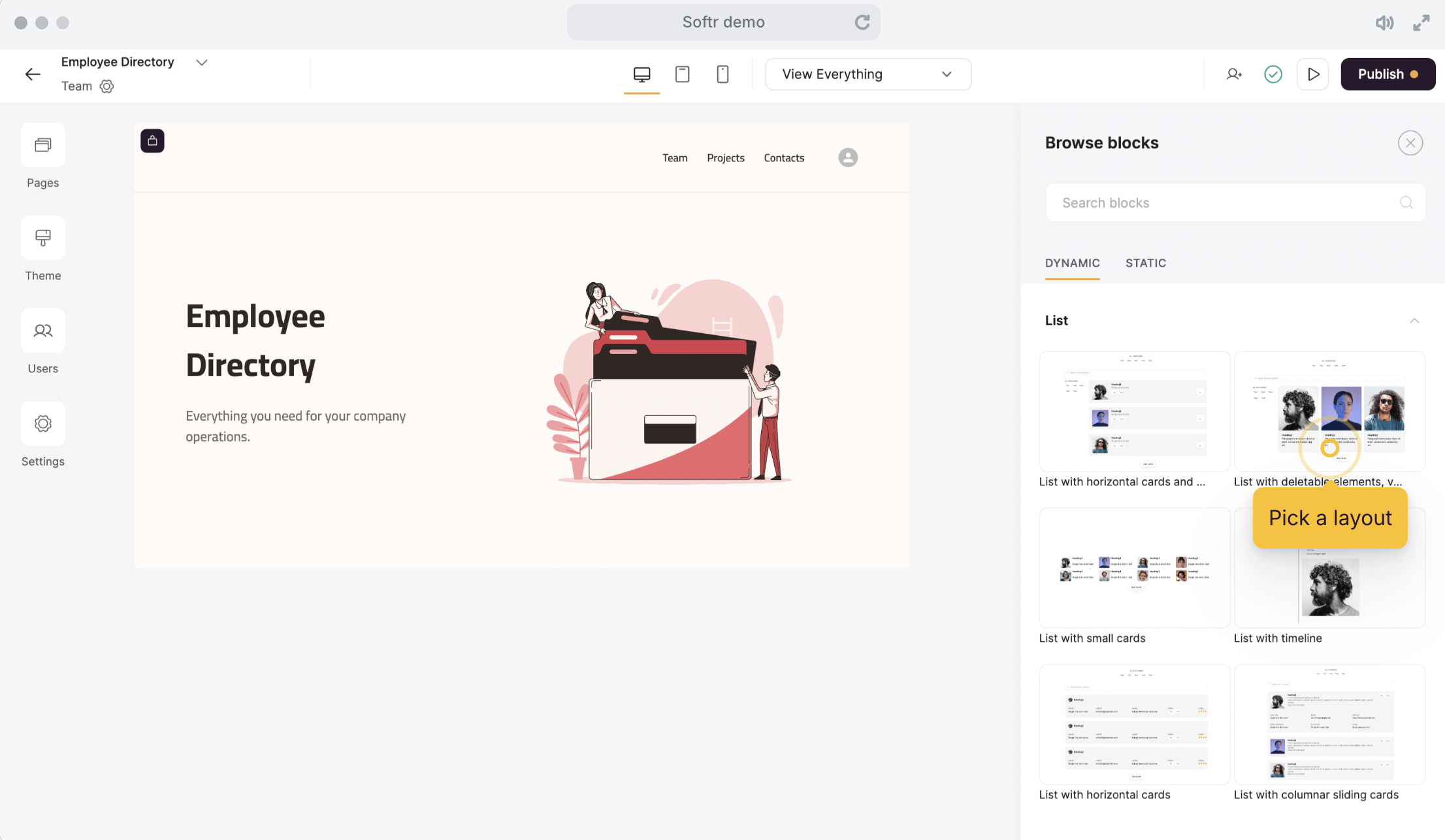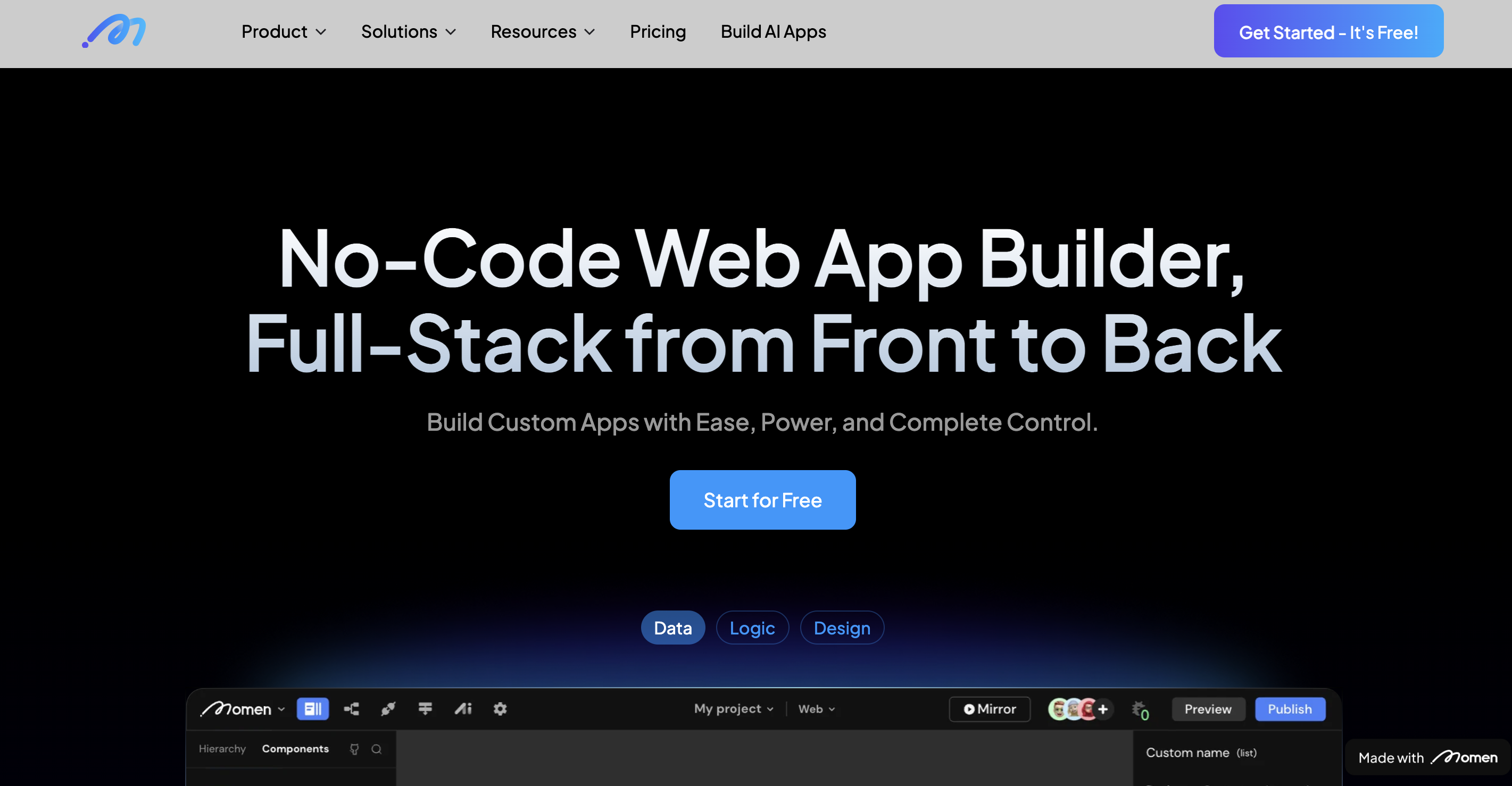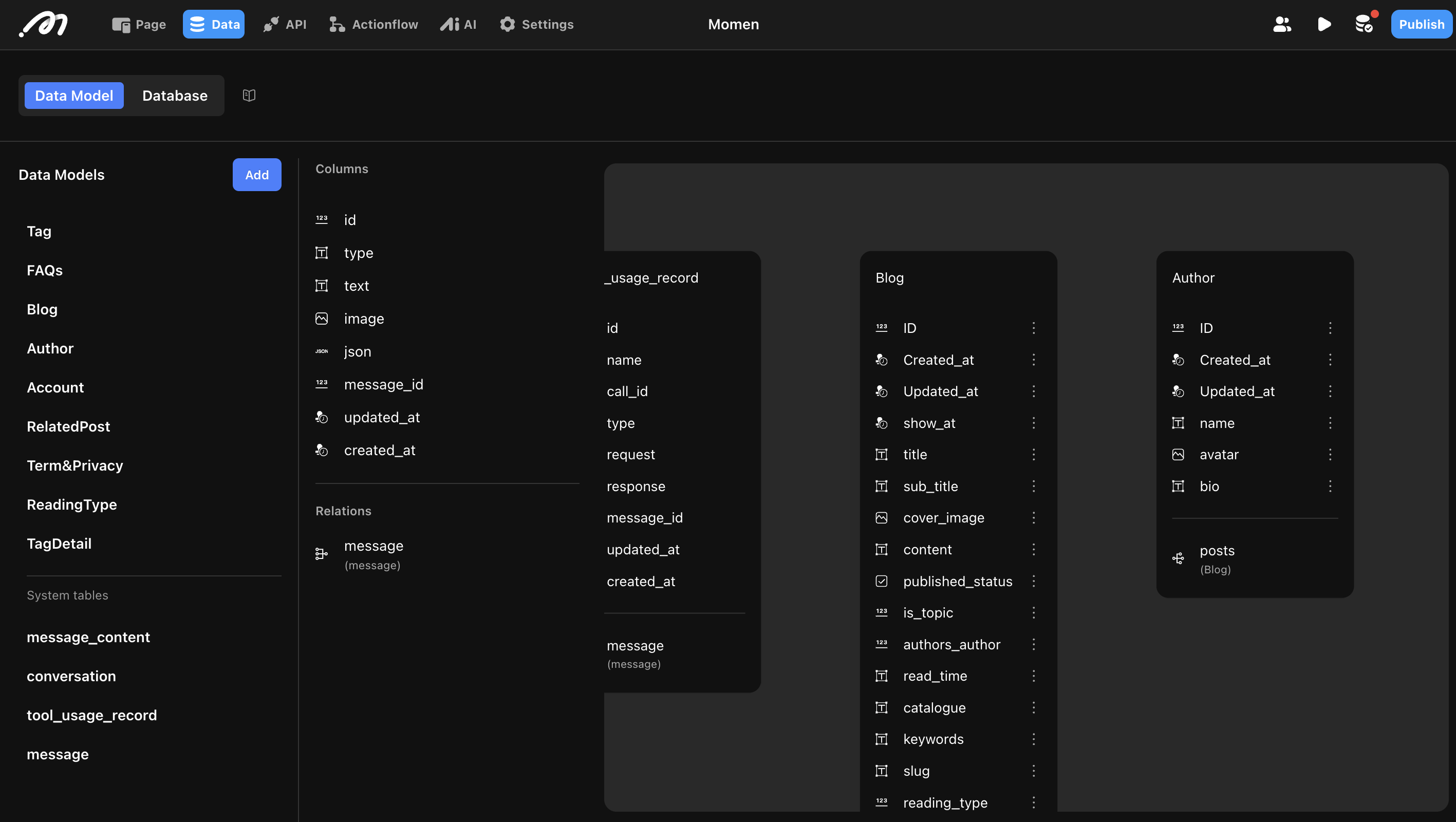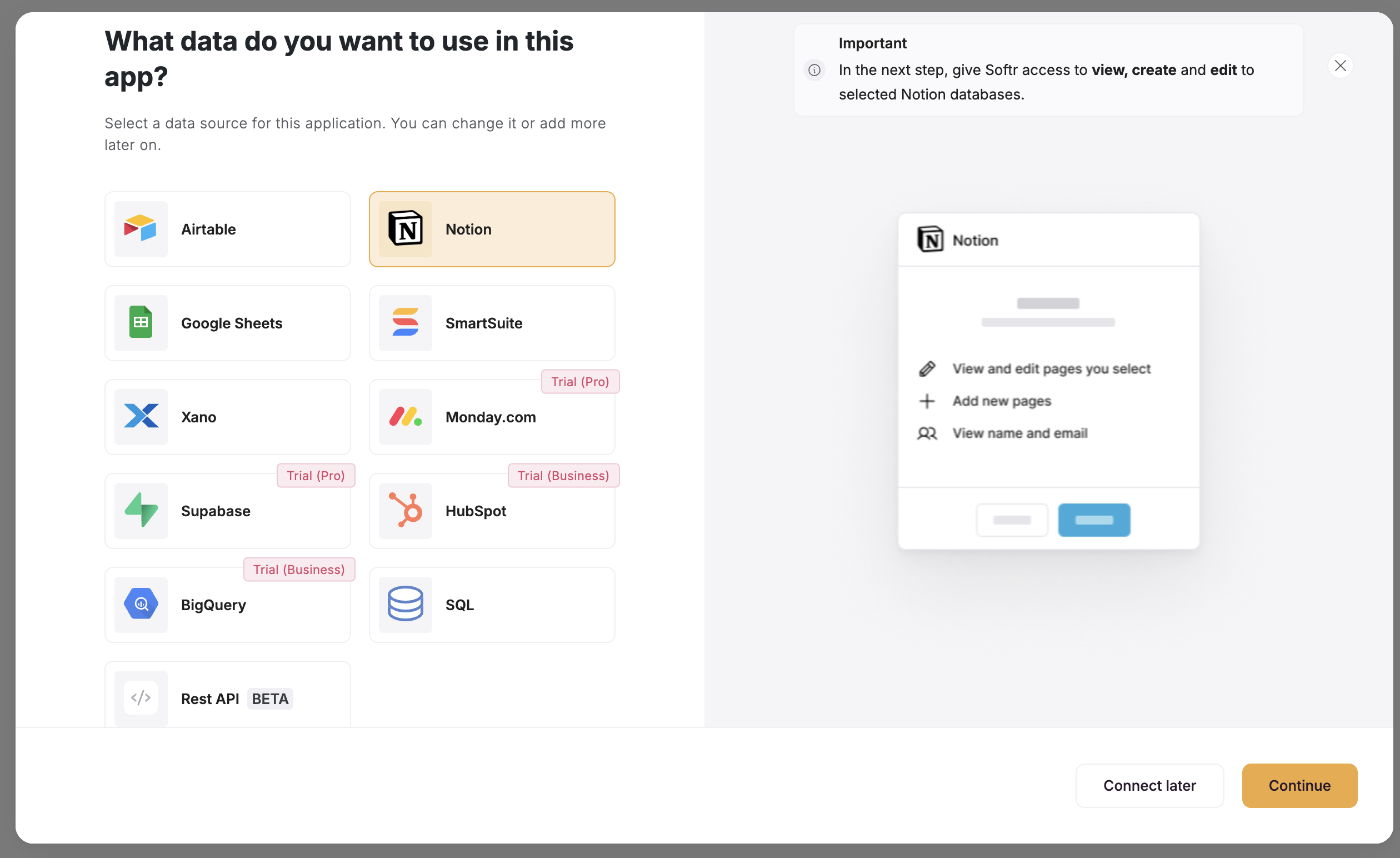Softr vs Momen: Choosing the Right No-Code Platform for Your Business Scale
The term "no-code" has been around for quite a while now, and it is used to emcompass so much it often becomes confusing. Softr and Momen are No-Code development platform that both started development at around 2020, and while they all target non-technical users wanting to build web applications, they present distinct approaches. In this article, I would like to provide a detailed comparison from the prospective of an engineer-turned-CEO.
Philosophical Differences
Softr: Simplicity Through Constraint
Softr embraces a widget-first philosophy, prioritizing immediate usability over customization or feature orthogonality (which is crucial for the composition of different feature). Their approach centers on providing pre-built blocks with limited but carefully chosen configuration options, making it particularly suitable for rapid deployment of internal tools as the users are typically not very picky about how the UI looks. The platform specifically targets users looking to create interfaces for existing data sources like Google Sheets or Airtable, without much scalability concerns.

Momen: Flexibility Through Architecture
Momen takes a fundamentally different approach, aiming to be a Turing-complete platform that prioritizes flexibility and customization. While this creates a steeper learning curve, it enables the development of fully-fledged, customer-facing applications with high daily active user (DAU) counts. The platform emphasizes predictability and complete control over the application's behavior, so that it may better serve the construction of customer-facing applications.

Development Experience and Interface Design
Visual Editors and UX
Softr offers essentially just a block-based UI editor with data binding capabilities. The editor shows the actual runtime UI using real data from external backends, though it cannot simultaneously display different visibility conditions. The combination makes it highly accessible to someone who has never touched programming, as the editor has very few options and does not need to image how the application looks when it actually runs. This comes at the cost of being restrictive to experienced frontend developers / designers.
Momen provides a comprehensive development environment, divided into UI, logic, and data sections. Its UI editor resembles design tools like Figma, and lets the editor create sequences of actions on frontend events such as button clicks. The platform also provides visual tools for database structure, API design, backend workflows, and AI agent configuration.

Version Control and Environment Management
Softr implements a snapshot system allowing developers to capture and restore application states. However, it lacks traditional development environment separation, primarily due to its reliance on external backend services.
Momen offers basic development environment support but currently lacks version control features. It does provide real-time collaboration capabilities, allowing multiple editors to work simultaneously with immediate synchronization.
Technical Capabilities
Frontend Development
The platforms differ significantly in their approach to frontend customization.
For Softr, options to customize components (it calls blocks) remains deliberately limited so it can maintain simplicity. The platform employs default responsive components with fixed behavior patterns, ensuring consistent experience across different screen sizes. No overrides are possible for different screen sizes other than visibility. Softr provides basic SEO capabilities such as title, description and H fields, though alt-texts for images are missing. You can inject html/js/css both into the page's header and as a custom block.
Momen takes a more comprehensive approach to frontend development. The platform offers extensive component and layout customization options that give developers granular control over appearance and behavior. Its responsive design system incorporates breakpoint-specific properties, allowing precise control over how components appear across different device sizes. This does come at the cost of higher configuration workload, as no reasonable "defaults" are given. Momen's React-based custom component support enables seamless integration with both other components and data from the project's backend. The platform includes comprehensive SEO features, going as far as allowing control of dynamic sitemap generation.
Backend Architecture
The architectural differences between the platforms are even more pronounced.
Softr's architecture relies entirely on external data sources, primarily integrating with Google Sheets, Airtable, and similar services. This approach results in typical latencies exceeding one second since each request incurs multiple service roundtrips. The platform implements basic role-based (it calls user group) permissions with limited condition nesting capabilities. Notably, Softr does not include a native workflow engine, aligning with its philosophy of simplicity.
Momen's architecture centers on its native PostgreSQL database integration, delivering typical latency under 200 milliseconds. The platform maintains ACID compliance throughout its operations, ensuring data consistency and reliability. Its comprehensive permission system combines both role-based and attribute-based access control, supporting complex conditions based on not just attributes of user and row, but also attributes of related entities and environment (such as time of day). Momen includes a full-featured workflow engine with JavaScript code block support, complemented by an integrated AI-agent builder that handles RAG, tool utilization and structured output. The platform automatically generates GraphQL APIs, enabling developers to build completely custom frontends based on it.
Overall, Momen's backend is much more powerful than Softr's. It should come at no surprise as Softr's philosophy is to "outsource" backend as much as possible.

Performance and Scalability
Performance Characteristics
Softr's performance is very limited partly due to its reliance on external data sources. Even on the top-tier business plan, the platform struggles with just 20 concurrent users, request latency can approach 10 seconds, and approximately 2% of requests result in server timeouts. These performance issues probably stem from the fact that each request from the browser has to go to Softr's servers, then to external data sources and back again, creating substantial latency overhead. The commonly chosen external data sources such as Airtable or Google Sheets are also not built with the performance required by customer-facing applications in mind, exacerbating the performance issue.

Momen, by contrast, demonstrates substantially better performance characteristics through its integrated architecture and careful engineering. By investing a lot of engineering time to implement features such as automatic index creation, direct GraphQL-to-SQL transformation (so an ORM with its performance overhead can be avoided), the platform's backend can efficiently handle tens of millions of rows per table while being able to process up to 3,200 requests per second when deployed on scaled-up single-tenant servers. This advantage has been proven in production environments, where the platform successfully supported an application with 120,000 daily active users while maintaining 99th percentile latency under one second.
Infrastructure Options
Softr provides no infrastructure choices, operating purely as a SaaS solution. Momen offers both multi-tenant and single-tenant deployment options, with additional support for bring-your-own-cloud (BYOC) deployment for enterprise customers.
Cost Analysis
Softr utilizes a per-account subscription model that includes unlimited applications, pricing ranging from free to $323 per month. Each tier has different limits for users (up to 2,500), user groups (aka roles), widgets and other functionalities. You have to pay for external backend services that can reach up to thousands of dollars per month (e.g. Airtable Enterprise).
Momen implements a per-project pricing model featuring tiered pricing based on features (such as number of workflows, payment integration) and usage (Requests per second, object storage, database storage and data outflow), ranging from free to $100 per month. Additional costs apply for cloud resources and single-tenant deployment options at $120 per month. Momen does not impose limits on database rows or accounts (which are treated as database rows in momen).
Overall, if you are building anything that may deal with a lot of data / a lot of users, Momen will be significantly cheaper.
Feature Table
Feature | Softr | Momen |
Database Type | External (Google Sheets/Airtable) | Native PostgreSQL |
Database Performance | >1s latency typical | <200ms latency typical |
Component Library | Limited blocks | Atomic components |
Layout | Block-based | Flex |
Version Control | Snapshot system | No |
Mobile Support | PWA only | Planned 2025 |
Custom Code | HTML/JS injection, iframes | HTML/JS injection, iframes, react Components |
Preview in Editor | Yes with actual data | No (hot-reloadable preview available) |
API Format | None | GraphQL |
Environment Support | Production only | Dev/Prod (basic) |
Collaboration | Page reloading needed | Real-time synchronization |
Debugging Tools | None | Logs with filtering |
Infrastructure Options | SaaS only | Shared instance/Single-tenant/BYOC |
SEO Features | Basic (title/description) | Comprehensive |
Workflow Engine | No | Yes |
AI Agent Builder | No | Yes |
Permissions System | Basic role-based | RBAC + ABAC with relations |
Maximum Scale | Under 20 concurrent users | 120k DAU proven |
Miscellaneous
Neither platforms offer exportability of any sort other than data, which is a moot point for Softr since it holds no data. This basically means if you were to move out, you lose all your UI configurations and logic.
Momen is planning native iOS/Android mobile support in 2025.
Best Use Cases
When to Choose Softr
1. Rapid Internal Tool Development
Softr excels at quickly deploying internal tools through its widget-first approach. The platform's real-time preview with actual data makes it particularly effective for business users who need to validate their applications immediately. The simplified interface and predefined blocks enable non-technical teams to create functional tools without extensive training or development experience.
2. Spreadsheet-Backed Applications
For organizations heavily invested in Google Sheets or Airtable, Softr provides seamless integration capabilities. The platform's ability to directly connect with these data sources means teams can leverage their existing data infrastructure while providing a more polished user interface. This makes it ideal for transforming spreadsheet-based processes into proper web applications without data migration.
3. Simple Customer Portals
Softr's block-based architecture makes it particularly suitable for creating straightforward customer portals and dashboards. The platform's built-in responsive design and PWA support ensure consistent user experience across devices. While customization options are limited, the predefined components cover most common use cases for basic customer-facing interfaces.
When to Choose Momen
1. Data-Intensive Applications
Momen's architecture is optimized for database performance, processing up to 5,000 rows per second, handling thousands of requests per second all while managing tens of millions of rows per table. The native PostgreSQL integration provides ACID compliance in multi-step workflows, along with advanced features like foreign key constraints and unique indexes. This makes it ideal for applications requiring strong data consistency and high-volume processing.
2. Complex Integration Requirements
Projects requiring sophisticated system integration benefit from Momen's comprehensive API capabilities. The platform generates GraphQL APIs automatically, with built-in features like introspection and comprehensive permissions. The combination of RBAC and ABAC support enables fine-grained access control, while the GraphQL architecture allows efficient data fetching with minimal roundtrips.
3. Scalable Customer-Facing Products
Momen caters to projects requiring professional-grade scalability and customization. The platform supports deployment to specific geographical regions through bring-your-own-cloud options. The React-based component system enables custom development when needed, while maintaining no-code accessibility. Extensive logging provide the observability required for production applications, making it suitable for serious business applications that need room to grow.
My own biased 2c
It is a hard one. I believe Softr and Momen represent two fundamentally different visions of what no-code development can be.
Softr's approach of extreme simplification through widgets works well for its target market - users who need to quickly build internal tools or simple customer-facing applications backed by spreadsheets. I can't see how there can be anything more though.
Here at Momen we try to empower non-technical founders to build applications that can match those created by code. While this creates a steeper learning curve, I think this is ultimately what non-technical founders are looking for, a professional tool. As their businesses grow, the demand for extensibility and scalability will only grow.
Conclusion: quick and dirty -> Softr, in for the long haul -> Momen.

